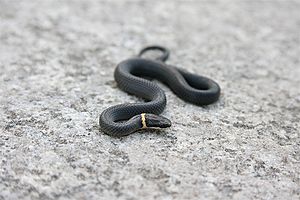Northern ringneck snake facts for kids
Quick facts for kids Diadophis punctatus edwardsii |
|
|---|---|
 |
|
| Northern ringneck snake | |
| Scientific classification |
|
| Kingdom: | Animalia |
| Phylum: | Chordata |
| Class: | Reptilia |
| Order: | Squamata |
| Suborder: | Serpentes |
| Family: | Colubridae |
| Genus: | Diadophis |
| Species: | |
| Subspecies: |
D. p. edwardsii
|
| Trinomial name | |
| Diadophis punctatus edwardsii (Merrem, 1820)
|
|
| Synonyms | |
|
|
The Northern ringneck snake (scientific name: Diadophis punctatus edwardsii) is a type of Ring-necked snake. It lives only in North America.
Contents
What's in a Name?
The second part of the snake's scientific name, edwardsii, honors a person named George Edwards. He was an English expert who studied birds. He described this snake long ago, even before it had its full scientific name.
What Does It Look Like?
The Northern ringneck snake has a body that can be bluish-grey or black. It has a bright yellow or orange ring around its neck. Its belly is usually the same color as the neck ring and doesn't have many dark spots.
This complete neck ring and the plain belly help tell it apart from other types of D. punctatus snakes. Adult snakes are usually about 10 to 15 inches (25 to 38 cm) long. Some can grow to be more than two feet (61 cm) long!
Where Do They Live?
You can find the Northern ringneck snake in parts of Canada and the United States.
In Canada, they live in southern Ontario, Quebec, and New Brunswick, as well as in Nova Scotia.
In the United States, they are found all over New England, the Mid-Atlantic states, and the Great Lakes region. They also live in higher, cooler areas in the southern states. Some of the states where they live include Connecticut, Massachusetts, New York, Pennsylvania, Ohio, Michigan, and Wisconsin.
How Do They Behave?
Northern ringneck snakes are active at night. They like to hide under rocks, fallen logs, and piles of leaves. Because they hide so well, people don't often see them, even if there are many around.
These snakes can also be social. You might find several ringneck snakes sharing the same hiding spot during any season.
Where Do They Like to Live?
These snakes prefer moist, wooded areas. They also use the edges of wetlands or open, hilly places. Sometimes, you might even find them in damp basements!
Reproduction and Life Cycle
Female Northern ringneck snakes lay their eggs in early summer. They usually lay 2 to 10 eggs under a rock or in moist, rotting wood. Sometimes, other female snakes will use the same spot, so you might find many eggs together!
The eggs hatch after about two months, usually in late summer. Baby snakes look just like the adults, but their neck ring and belly might be a bit brighter. The eggs are about 0.8 to 1.3 inches (21–34 mm) long. When they hatch, the baby snakes are about 4 to 5 inches (100–125 mm) long.
In the winter, these snakes go into hibernation. They might hide in stone walls, cellars, small mammal burrows, or even brush piles and rotting logs to stay warm.
What Do They Eat?
Northern ringneck snakes eat a variety of small creatures. Their diet includes insects, salamanders, earthworms, slugs, small lizards, tiny snakes, and frogs. The Red-backed salamander is one of their favorite foods!
Who Eats Them?
Larger animals also prey on Northern ringneck snakes. These include bullfrogs, toads, several types of birds, and mammals like shrews. Very young ringneck snakes can even be eaten by large centipedes or big spiders.

